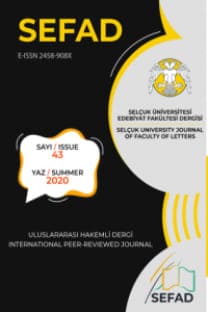Philippe Claudel’in Bay Linh ve Torunu Romanında Zamanötesi ve Uzamötesi Anlatı
Bu çalışmanın bütüncesi çağdaş Fransız romancı Philippe Claudel’in göç, sürgün, travma ve arkadaşlık temalarının işlendiği Bay Linh ve Torunu romanından oluşur. Adı geçen eser bebek torunu hariç ailesinin tamamını kaybeden yaşlı bir adamın dilini bile bilmediği bir yere göç etmesini ve burada yaşadıklarını konu edinir. Torunu için hayata tutunmaya devam eden Bay Linh’in yaşadıkları hikâye dışı üçüncü tekil anlatıcı tarafından aktarılır. Baş kahramanın yaşam izlencesinden yola çıkarak gerçek ve kurmaca ilişkisi romanda “gizlenen” ve “gösterilen” ikilisi üzerinden irdelenir. Anlatıcının romanın sonuna kadar anahtar ögelerden birini gizleyerek oluşturduğu beklenmedik son, okuyucunun bilincinde metnin yeniden anlamlandırma sürecine başlamasına zemin hazırlar. Bununla birlikte hikâye evreninin kesin olmayan zaman ve yer belirteçlerinden oluşturulduğu eser, olayların bir yere ya da bir zamana indirgenmeden ortak bir bilince hitap etmesine imkân sağlar. Karakter isimlerinin sınırlı kullanımı da bu durumu destekler. Söz konusu zamansal ve uzamsal çerçevenin belirsiz bırakılması anlatının zamanötesi ve uzamötesi bir yapıya bürünerek belirli bir kesimin değil ortak bir belleğin gerçekliğini yansıtan bir roman olarak değerlendirilmesini sağlar. Bu çalışmada Bay Linh ve Torunu romanının anlatı evrenine ışık tutmak ve roman kurgusunu ortaya koymak için eser, anlatıbilim, gerçeklik etkisi bakış açıları ve kurmaca kuramları ışığında ele alınır. Makalede anlatıcının güvenilmezliği, kurmacanın gerçeklik özelliği ve anlatının zamansal/uzamsal çerçevesinin anonimleşmesi konularının incelenmesi amaçlanır. Belirtilen ögelerin üzerinde durulduğu incelemede metod olarak “olası dünyalar” ve “gerçeklik etkisi” temel alınır. Nitel bir araştırma kapsamında yazılı dökümanların analizi yöntemi izlenerek yorumlayıcı bir çalışma ortaya konulur.
Anahtar Kelimeler:
Göç, sürgün, güvenilmez anlatıcı, uzamsal-zamansal çerçeve, kurmaca
Transtemporal and Transspatial Narrative in Philippe Claudel’s Monsieur Linh and his Child
The corpus of this work consists of the contemporary French novelist Philippe Claudel's book named Monsieur Linh and his child which focuses on the themes of migration, exile, trauma and friendship. In this book, the emigration of an old man who lost his entire family except his baby grandson, to a place where he does not even know its tongue and his experiences are discussed. The events that happen to Mr. Linh who hold on to life for his grandson are narrated by a third singular narrator. Focusing on the protagonist's life, the relationship between reality and fiction is examined through the pair that is "hidden" and "shown" in the novel. Concealing one of the key elements until the end of the novel, the unexpected end of the narrator paves the way for the reader to begin the process of re-understanding the text. However, the story universe of the novel is composed of uncertain time and place markers and this allows the events to address a common consciousness without being reduced to a place or a time. The limited use of character names also supports this notion. Suspending the temporal and spatial framework indefinitely enables the narrative, which transforms into a trans-temporal and trans-spatial structure, to be considered as a novel that reflects the reality of a common memory, not a particular segment. In this study, in order to shed light on the narrative universe of Mr. Linh and his child and to reveal the fiction of the novel, it is aimed to discuss the work within the scope of narrative, reality effect perspectives and fiction theories. The objective of this article is to examine the narrator's unreliability, the realistic feature of fiction, and the anonymization of the temporal / spatial framework of the narrative. In the study which emphasizes the mentioned elements, “possible worlds” and "reality effect" are taken as the basis methods. Within the scope of a qualitative research, an interpretive study is created by following the analysis method of written documents.
Keywords:
Migration, exile, unreliable narrator, spatio-temporal framework, fiction,
___
- Adam, J.-M. (1987). Types de séquences élémentaires. Pratiques, 56, 54-76.
- Barthes, R. (1982). L’effet de réel. In collectif, Littérature et réalité (pp. 84-89). Paris : Seuil.
- Claudel, P. (2005). La petite fille de Monsieur Linh. Paris : Stock. Retrieved from https://www.amazon.fr/petite-fille-Monsieur-Linh-Bleue-ebook/dp/B005OJ4SO6/ref=tmm_kin_swatch_0?_encoding=UTF8&qid=&sr=
- Claudel, P. (2007). Bay Linh ve Torunu. (İlksavaş, Y. Çev.). İstanbul: Doğan.
- Del Lungo, A. (1993). Pour une poétique de l’incipit. Poétique, 94, 131-152.
- Eco, U. (1985). Lector in fabula ou la coopération interprétative dans les textes narratifs. Paris : Grasset.
- Genette, G. (1983). Nouveau discours du récit. Paris : Seuil.
- Iser, W. (1985). L'Acte de lecture. Théorie de l'effet esthétique. Bruxelles : Mardaga.
- Jouve, V. (1993). La Lecture. Paris : Hachette.
- Parent, A. M. (2006). Trauma, témoignage et récit : la déroute du sens. Protée, 34 (2-3), 113–125. https://doi.org/10.7202/014270ar, 31.12.2019.
- Pavel, T. (1988). Univers de la fiction. Paris : Seuil.
- Riffaterre, M. (1982). L’illusion référentielle. In collectif, Littérature et réalité (pp. 91-118). Paris: Seuil.
- Rullier-Theuret, F. (2001). Approche du roman. Paris : Hachette.
- Yayın Aralığı: Yılda 2 Sayı
- Başlangıç: 1981
- Yayıncı: Selçuk Üniversitesi Edebiyat Fakültesi
Sayıdaki Diğer Makaleler
Mustafa YENİASIR, Burak GÖKBULUT, İ̇smail TAMER
Sosyolojiye Çağrı: Hümanist Bir Perspektif
Silifke Uzuncaburç’ta Geleneksel Yöntemlerle Pekmez Yapımı Üzerine Halk Bilimsel Bir İnceleme
Ömer Seyfettin'in “Horoz” ve “Dünyanın Nizamı” Hikâyelerini Modernizm Çerçevesinde Okumak
15 Temmuz Darbe Girişimi Sonrasında Demokratik Bilincin Kutsal Bileşenleri
Mekke’de Bir ‘Alman’ Seyyah: Ilija Trojanow
Trabzon Geleneksel Mutfağında Tatlılar ve Çekme Helva
Geçmiş ve Şimdinin Çatışması: Oscar Wilde’in Şiirinde Tarihsel ve Temsil Mekanlarının Üretimi
Nal Sesleri Abbas Sayar’ın Yılkı Atı Adlı Romanının Zoopoetik Bir Okuması
Yabancı Dil Olarak Türkçe Öğrenenlerin Bağdaşıklık Araçlarını Kullanma Düzeyinin Değerlendirilmesi
